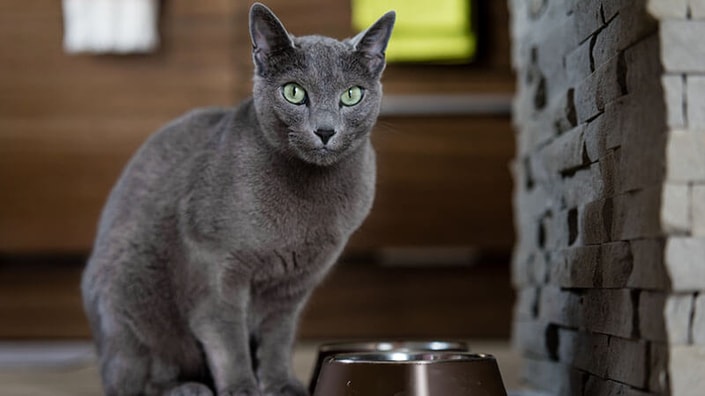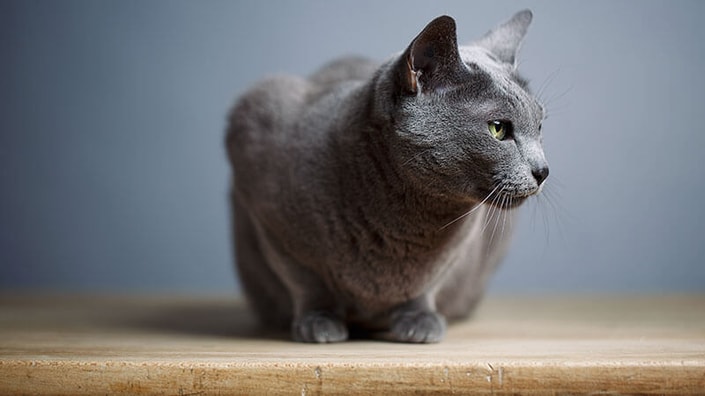9 WEIRD EATING HABITS IN CATS — AND WHAT TO DO ABOUT THEM
Every person with a cat has experienced this moment: Your cat lets you know it’s time to eat, and they stroll to their typical dining spot and wait to be served. You happily oblige, yet you’re a bit nervous as you anxiously watch your cat, hoping for their approval. They sniff the bowl, perhaps take a nibble. And then, if you’ve chosen well, your cat begins to eat and you exhale in relief — no snub today at your cat café.
Cats can be rather discerning eaters. In one sense, that means they like what they like … and tomorrow, for no apparent reason, they might not like it anymore. Or they might still like the same food but adopt a new mealtime habit. Let’s explore some of the most common strange eating behaviors cats engage in and find out which ones are concerning and which are just plain curious.
First, what’s “normal eating behavior” for a cat?
Normal eating habits are a blend of natural and learned behaviors. Every cat is hardwired to be carnivorous, so many of them are just fine with a high-quality, protein-packed wet cat food. A cat’s eating habits can also be influenced by what they were fed as a kitten, leading them to favor certain forms, textures and flavors. Switching to an unfamiliar food can leave your cat confused — and hangry. But in general, you want your cat to have an even appetite and be rather nonchalant around people and other pets while dining.

9 eating oddities in cats
As sophisticated as cats are (in fact, they’ve informed us they prefer to be called “felines”), they can nevertheless exhibit eating behaviors that are, in a word, strange.
1. Munching on plants
Eating greenery is pretty common and perfectly normal. It’s thought that wild cat species feed on grass to aid in digestion; domestic cats satisfy this drive by nibbling the houseplants. There’s no reason to prune back this behavior, but take care that only cat-safe plants are within reach since many houseplants are toxic to pets.
2. Playing with their food
If your cat is swatting their food across the floor, it’s not because they’ve seen cranky toddlers doing the same to their vegetables. Cats are hunters by nature — they expect mealtime to include a chase. So, pawing at their food isn’t a critique of the chef’s efforts. In fact, this is healthy activity for your cat: good for nurturing their instincts and burning calories.
3. Gorging
We don’t typically think of cats as gorgers — dogs are the ones “wolfing” down their food, right? If your cat chows down like the buffet is closing, it could be a competitive response to other pets in your home. Or if you’ve warmed up wet food for them, your cat might be trying to finish it before it cools. To counter the gorging, try feeding smaller amounts several times a day instead of two larger meals twice a day. Or consider purchasing a food dish or mat designed to slow down eating and encourage your cat’s foraging behavior.
4. Refusing to eat alone
When eating, it’s not unusual for cats to seek solitude in a comfortable place where they feel safe from other predators looking to steal a meal — or worse, turn them into a meal. On the other end of the spectrum are cats that will only eat when you keep them company. If you leave the room, they might stop eating, follow you out and even complain vocally. Sometimes called “affection eating,” this behavior could be a reaction to the stress of a different environment and/or new people. Extra bonding time and activities can gradually reduce their stress and encourage independent eating.
5. Bringing home “trophies”
Nothing ratchets up the feline instincts like being outdoors: the smells, sounds and sights are simply intoxi-cat-ing! If your cat is a capable hunter and spends time outside, then you probably discover the unfortunate victims on your back porch now and then. While expert opinions vary on why they do this, it’s clear that cats will hunt no matter how well you feed them — predatory instincts trump all. Just be aware that contact with and eating wild animals can expose your cat to various parasites and anything harmful that their prey might have ingested.
6. Eating nonfood items
When cats chew or eat things that are clearly not food, they have a condition called pica. Cats that suck on fabric items such as wool, fleece or stuffed animals could be compensating for being weaned too early. More problematic is a cat that eats nonfood items: paper, plastic bags, shoelaces, rubber bands, rocks, dirt and soap, to name a few. Suspected causes include dietary deficiencies, medical issues, their genetic background, compulsion and lack of stimulation. Whatever the cause, intestinal blockage is a serious threat. The first step is a visit with your vet to look for underlying medical problems.
7. Eating poop
Eating what? Again, you might think this behavior is a “dog thing.” But to be honest, even the most composed cat can get caught with their head in the litter pan. Known clinically as coprophagia, it’s a normal grooming habit for mothers with newborn kittens. For any other cat, though, it could be driven by medical issues, parasites, neurological diseases or psychological disorders. Talk with your vet to figure out the root cause and what course of treatment your cat needs.
8. Eating too much
Obesity doesn’t just afflict humans anymore — our pets suffer from it, too. While we definitely won’t cat shame anyone, if your feline sports an extra-full figure, it can accelerate joint wear and lead to arthritis, diabetes mellitus or cardiovascular issues. In addition to a diet focused on weight management and joint support, overweight cats can benefit from feeders that slow down the eating process. And as with humans, don’t begin any serious weight-management regimen without first consulting your vet.
9. Not eating
It can be alarming to find that your cat has just stopped eating. Before you do anything else, consider any recent changes in the menu. A switch in cuisine can stress a cat out — if consistency helps them feel safe, a food change can be disruptive. However, if your cat hasn’t recently experienced a change in their diet, environment or routine and they stop eating, see a vet immediately. Causes range from a simple toothache to a serious illness. Loss of appetite could also be the side effect of a recent vaccination. Whatever the reason, going without food for even a few days can create a condition called fatty liver, which itself can lead to various complications and eventually death.

Cats are resilient and capably independent companions, but unusual or unexpected changes in how they eat reveal the complexity of their personalities and physiology. Make it part of your relationship with your cat to notice their eating habits, and you’ll help set the table for many happy mealtimes together.
Placeholder for the 'Salesforce Datalayer Tag Block' field
